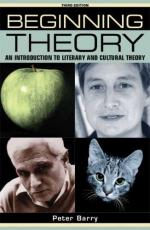
|
| Name: _________________________ | Period: ___________________ |
This test consists of 15 multiple choice questions and 5 short answer questions.
Multiple Choice Questions
1. According to the narrator in the Introduction, what two introductions to theory sources deal with the problems of teaching or learning theory?
(a) The Use of English and The English Review.
(b) After Theory and The Critical Decade.
(c) The Oval Portrait and The End of English.
(d) Literary Studies in Action and Texts and Contexts.
2. The narrator informs the reader that in the early 1980s, two new forms of political/historical criticism emerged, new historicism from ________ and cultural materialism from ________.
(a) Russia / the United States.
(b) Britain / Russia.
(c) The United States / Britain.
(d) France / Germany.
3. What language does the narrator describe as being a Romance language that takes most of its words directly from Latin, and lacks the reassuring Anglo-Saxon layer of vocabulary?
(a) English.
(b) Spanish.
(c) French.
(d) German.
4. All of the following religious believers were not allowed to attend university in England in the nineteenth century except which one?
(a) Catholic.
(b) Jewish.
(c) Anglican.
(d) Atheist.
5. The Introduction states that ________, like novelists, are dauntingly plentiful.
(a) Poets.
(b) Romanticists.
(c) Theorists.
(d) Journalists.
6. What example did Saussure use to explain what he meant by saying that there are no intrinsic, fixed meanings in language?
(a) 1984.
(b) 8.25 Geneva to Paris.
(c) Animal Farm.
(d) Ulysses.
7. What term suggests a range of negative attributes, such as "non-Marxist" and "non-feminist," and "non-theoretical"?
(a) Humanism.
(b) Absurdism.
(c) Dialogism.
(d) Modernism.
8. Which of the following works did the narrator believe to be the most important Lacanian text for literary students and which was first delivered in 1957 to a "lay" audience of philosophy students?
(a) The Insistence of the Letter.
(b) The Four Fundamental Concepts of Psychoanalysis.
(c) Fetishism: the Symbolic, the Imaginary and the Real.
(d) The Signification of the Phallus.
9. In Julia Kristeva's essay "The System and the Speaking Subject," the ________ aspect is associated with authority, order, fathers, repression, and control.
(a) Symbolic.
(b) Semiotic.
(c) Natural.
(d) Imaginary.
10. The narrator explains in the chapter "Psychoanalytic Criticism" that distrust of Freud has grown in recent years, partly as a result of his mainly negative views on ________.
(a) Men.
(b) Americans.
(c) Women.
(d) Children.
11. Which of the following terms best fit the following definition: "a form of literary criticism which uses some of the techniques of psychoanalysis in the interpretation of literature"?
(a) Psychoanalytic criticism.
(b) Impressionistic criticism.
(c) Applied criticism.
(d) Practical criticism.
12. Who said the following quote found in the chapter titled Theory Before Theory--Liberal Humanism: "We are told that the study of literature 'cultivates the taste, educates the sympathies and enlarges the mind'"?
(a) Edward Freeman.
(b) Oscar Wilde.
(c) Lewis Carroll.
(d) Elie Wiesel.
13. The chapter "Psychoanalytic Criticism" states that ________ is the notion that sexuality begins not at puberty, with physical maturing, but in infancy, especially through the infant's relationship with the mother.
(a) Infantile sexuality.
(b) Pansexuality.
(c) Polysexuality.
(d) Omnisexuality.
14. Who was the first critic to develop a "reader-centered" approach to literature?
(a) Plato.
(b) Aristotle.
(c) Sigmund Freud.
(d) Sophocles.
15. According to Peter Barry in the chapter titled "Post-Structuralism and Deconstruction," post-structuralist critics seek to show that the text is characterized by ________ rather than unity.
(a) Discourse.
(b) Genre.
(c) Indeterminacy.
(d) Disunity.
Short Answer Questions
1. Peter Barry examines Sigmund Freud's book ________, which in the chapter "Psychoanalytic Criticism" Barry claims is one of Freud's most enjoyable and accessible publications.
2. According to the narrator in the Introduction, the term "liberal humanism" became current in what decade?
3. According to the chapter titled Post-Structuralism and Deconstruction, structuralism derives ultimately from ________.
4. David Lodge, Professor of English at Birmingham, combined the ideas of structuralism with more traditional approaches in which one of his books?
5. What term does the narrator explain was a popular term in deconstructive criticism and literally means an impasse?
|
This section contains 606 words (approx. 3 pages at 300 words per page) |

|




